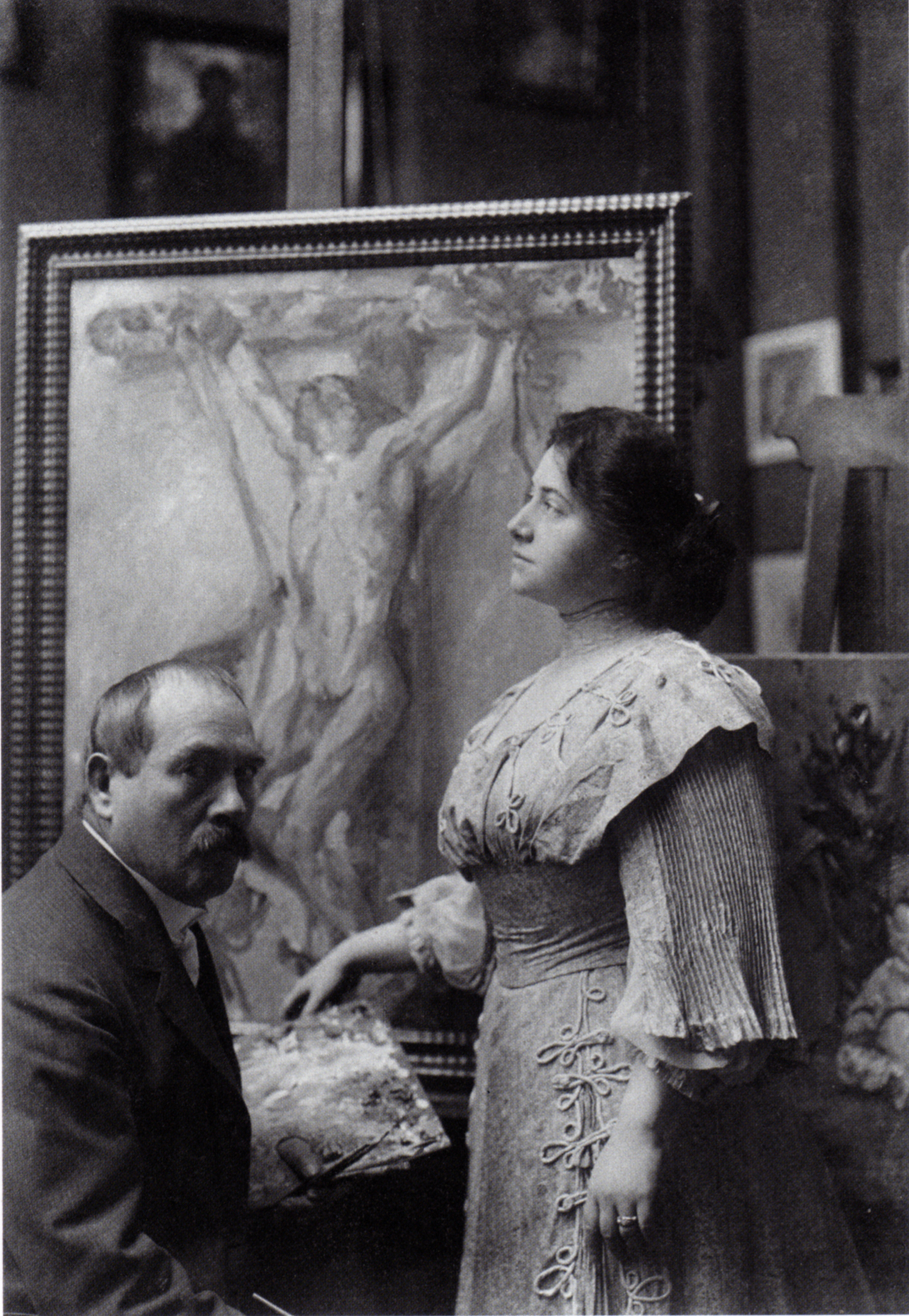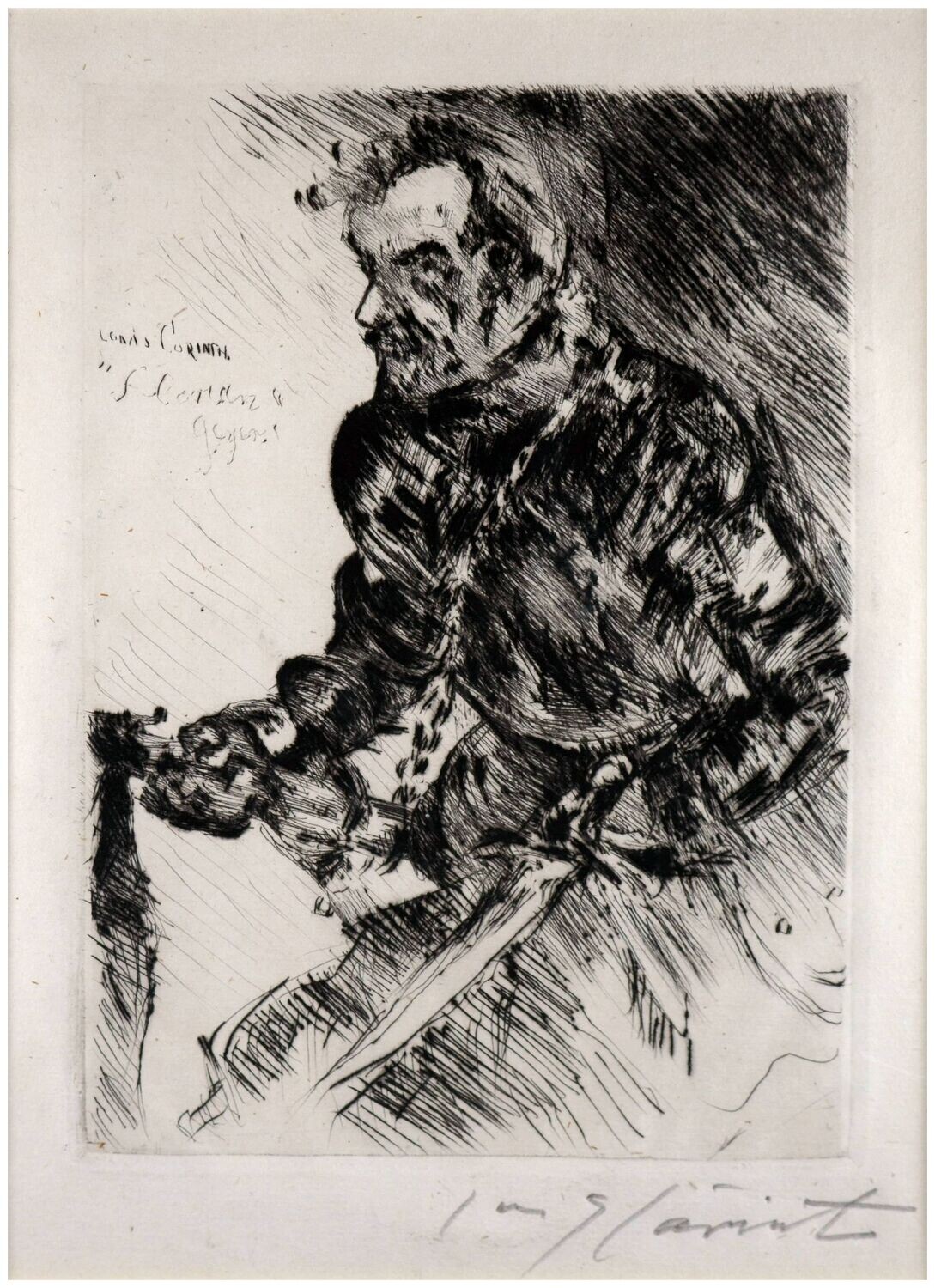Corinth, Lovis (1858-1925), Rudolf von Rittner as Florian Geyer, 1924
Lovis Corinth(1858 Tapiau - 1925 Zandvoort), Rudolf von Rittner as Florian Geyer , 1924 (Müller 854), drypoint signed in pencil. 20.4 × 14.2 (plate size), 37.7 × 30.6 cm (sheet size). Published by Karl Nierendorf, Berlin. Framed in a passepartout.
- Strong, precise impression. Browned outside of the image. Frame a little bit rubbed and with two small damages.
- Last man standing
-
The knight is a leitmotif in Lovis Corinth's work, culminating in his Self-Portrait in Armour of 1914. Of all the paintings on this theme, Corinth most often depicted Florian Geyer. Descended from a Franconian noble family, he fought for the freedom of the peasants during the peasant wars of the Reformation, first diplomatically and then militarily, leading the legendary Schwarzen Haufen (Black Troops). The name derives from the black uniforms with which Geyer dressed the peasants willing to fight.
During the Napoleonic occupation, the freedom fighter Florian Geyer was sung about by the Romantics, and the free corps Die Schwarze Schaar
, founded in 1813 by Major von Lützow, succeeded the Schwarzer Haufen. It was against this historical background that Gerhard Hauptmann wrote the revolutionary drama Florian Geyer
, which premiered at the Deutsches Theater in Berlin in 1896. While the actor Rudolf Rittner, who would later appear in Fritz Lang's films, initially played the role of Schäferhans, he took over the leading role in the new production at Berlin's Lessing Theatre in 1904, again directed by Emil Lessing, which established his fame as an actor. Hauptmann himself praised the acting. He wrote to Hugo von Hofmannsthal: "It went quite well with Florian Geyer. In any case, I had the great pleasure of seeing the play again in an admirable performance". And Lovis Corinth was so taken with Rittner's performance that he painted an oil portrait of him in the role of Florian Geyer in 1906.
After two further graphic versions in 1915 and 1920/21, Corinth returned to the painting a year before his death and almost twenty years after the oil painting to create this graphic version in 1924. Even the inscription in the picture was taken over. This proves all the more the importance of the knight and freedom fighter for Corinth's self-image.
The oil painting, in particular, proclaims the single-minded determination to fight to the last for the values defended, manifested in the oil painting by the tattered flag held out to the enemy. There is a parallel with Rainer Maria Rilke's 1899 story The Cornet , in which the protagonist goes down with the flag that he first saved at the risk of his life.
Consequently, the portrait is also a self-portrait, and the knight's armour is not an academic costume or an ironic refraction, but an expression of Corinth's self-image, which also includes his self-representation as an artist. The Secession poster for the exhibition of his life's work in 1913 depicts Florian Geyer. Art is also a struggle, the will to gain more and more ground through one's work. In this sense, Corinth is an avant-gardist without being part of the avant-garde. He is a lone fighter, not a member of a fighting group - Florian Geyer without his Schwarzem Haufen
, all alone. For Corinth, this fight had its own fateful dimension: it was the fight with and against his own body after the paralysis caused by the stroke he suffered in 1911. And if we compare the exemplary oil painting with the late etching, for example the shape of the head or the left arm, the ductus itself seems like a battle event from which the knight emerges. This gives the etching its own artistic quality compared to the oil painting.
About the artist

Determined to become an artist, Corinth entered the Königsberg Art Academy in 1876, where he studied under Otto Günther, who introduced him to Weimar plein-air painting. On Günther's recommendation, Corinth moved to the Munich Art Academy in 1880. There, under the influence of the circle of Leibl and Wilhelm Trübner, he adopted a naturalistic approach to art that was opposed to academic history painting.
After interrupting his studies for a year to do voluntary military service, Corinth went on a study trip to Italy in 1883 and the following year to Antwerp, where he took art lessons from Paul Eugène Gorge. From 1884 to 1887, Corinth stayed in Paris and devoted himself mainly to nude painting at the private Académie Julian.
After a stopover in Berlin, where he met Max Klinger, Walter Leistikow and Karl Stauffer-Bern, Corinth lived in Munich from 1891 to 1901 and became a founding member of the Munich Secession, which was founded in 1892 by Max Liebermann, Otto Eckmann, Thomas Theodor Heine, Hans Olde, Hans Thoma, Wilhelm Trübner, Franz von Stuck and Fritz von Uhde. The Secession gave rise to the Free Association of the XXIV or Munich 24, to which Corinth also belonged.
In 1894, under the tutelage of Otto Eckmann, Corinth learnt the art of etching and, in the field of painting, developed the wet-on-wet style that would characterise his work and lead to the relief-like texture of his paintings.
His relationship with Berlin became more and more intense. When he attended the first exhibition of the Berlin Secession in 1899, he painted a portrait of Liebemann, who in turn painted a portrait of Corinth. After the Munich Secession rejected his painting Salome, he finally moved to Berlin, where the painting was admired at the Secession exhibition and Corinth - through Leistikow - became a much sought-after portraitist.
In 1903 Corinth opened an art school and in 1904 he married his first pupil, Charlotte Berend. His first solo exhibition was organised by Paul Cassirer. In Berlin, Corinth also began to devote himself to the theatre. He worked with Max Reinhardt, designing sets and costumes.
Following Max Liebermann's resignation, Corinth was elected chairman of the Secession in 1911. In the same year, he suffered a stroke that paralysed half of his body. He then devoted himself intensively to graphic art and opened up the field of book illustration.
In 1913, Paul Cassirer organised the first major retrospective of Corinth's work, and in 1918, on his 60th birthday, the Berlin Secession devoted a major exhibition to his work. In 1923, on his 65th birthday, his artistic career was crowned with a extense solo exhibition at the National Gallery.
Even after the 'Freie Sezession' split from the 'Berliner Sezession', Corinth remained in the original association, becoming chairman again in 1915 and professor at the Berlin Academy of Arts the following year.
In 1919, the Corinths purchased the retreat at the Walchensee in Bavaria, which Corinth captured in more than 60 paintings. Corinth died in 1925 on a trip to Amsterdam to see his great idols, Frans Hals and Rembrandt.
Selected Bibliography
Heinrich Müller: Die späte Graphik von Lovis Corinth, Hamburg 1960.
Thomas Deecke: Die Zeichnungen von Lovis Corinth. Studien zur Stilentwicklung, Berlin 1973.
Zdenek Felix (Hrsg.): Lovis Corinth. 1858–1925, Köln 1985.
Karl Schwarz: Das Graphische Werk von / The Graphic Work of Lovis Corinth, San Francisco 1985.
Horst Uhr: Lovis Corinth, Berkeley 1990.
Charlotte Berend-Corinth: Lovis Corinth: Die Gemälde. Neu bearbeitet von Béatrice Hernad, München 1992.
Peter-Klaus Schuster / Christoph Vitali / Barbara Butts (Hrsg.): Lovis Corinth, München 1996.
Michael F. Zimmermann: Lovis Corinth, München 2008.


